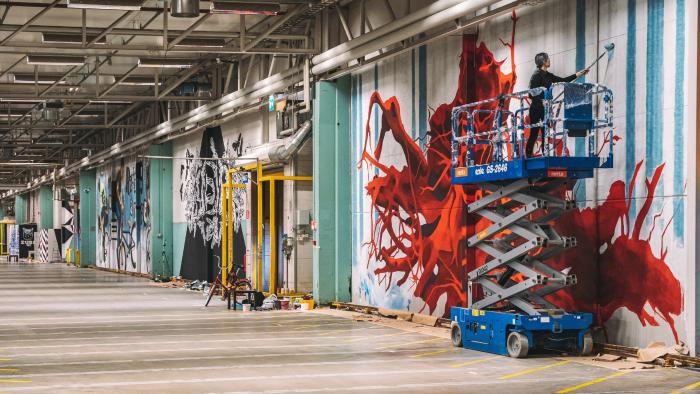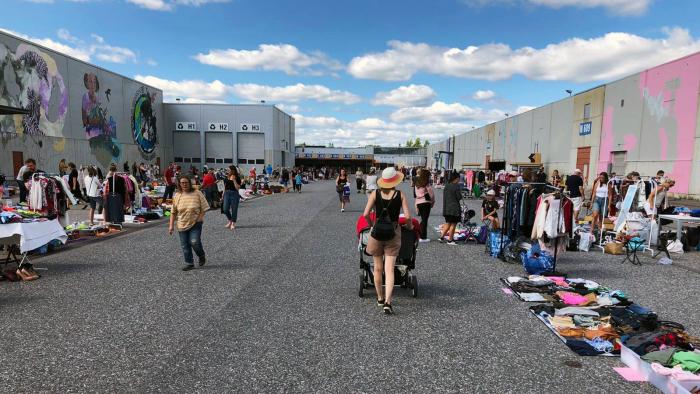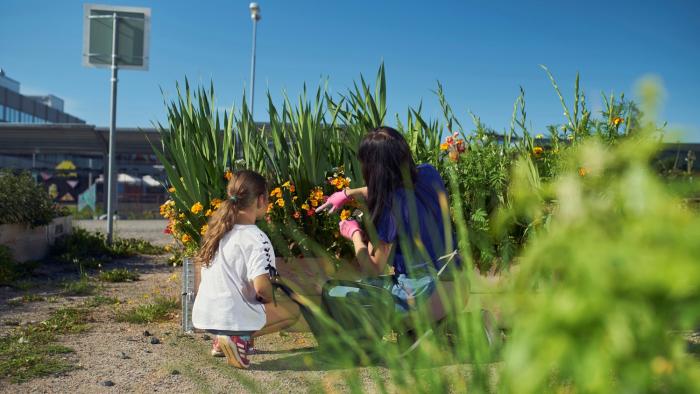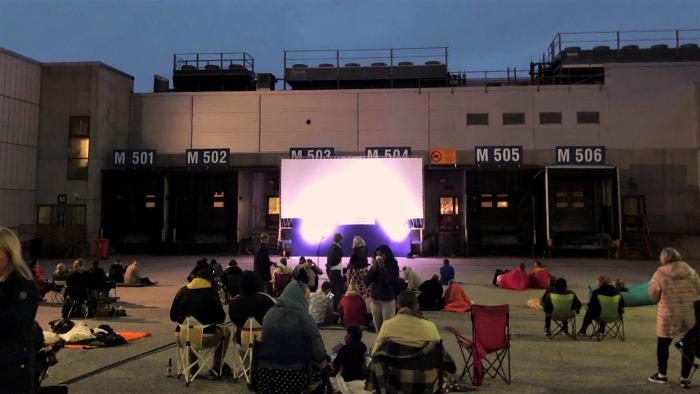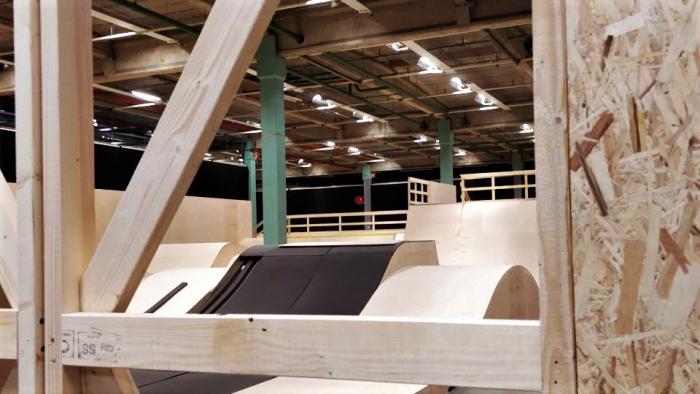I. SUMMARY INFORMATION
Project
268172
Status
Submitted
Award category
Regenerated urban and rural spaces
You want to submit
NEW EUROPEAN BAUHAUS AWARDS : existing completed examples
Project title
New Kera – a smart urban platform
Full project title
Kera – from an industrial district to a testbed for sustainable, circular and regenerative solutions
Description
Kera is an old industrial area located in Espoo, Finland, where the entire district has been transformed into a testbed for sustainable, circular and digital solutions using methods of co-creation. It exemplifies how the co-operation of citizens, local companies, researchers and the public sector can result in inspiring change. Kera is co-creation, experiments, urban culture, festivals, green solutions, urban farming, 5G smart poles, good living and more – all on one platform.
Where was your project implemented in the EU?
Finland
Uusimaa
Kera, 02630 Espoo
60.216683
24.759102
City of Espoo
02630
When was your project implemented?
Has your project benefited from EU programmes or funds?
No
Which programme(s) or fund(s)? Provide the name of the programme(s)/fund(s), the strand/action line as relevant and the year.
II. DESCRIPTION OF THE PROJECT
Please provide a summary of your project
In 2019 the city initiated the new Kera project to transform Kera into a collaborative platform promoting new, creative, sustainable, circular, regenerative and digital solutions. Kera is an old industrial district in the city of Espoo, one of the four municipalities that make up the Helsinki metropolitan area. Espoo is a growing city that is at the forefront of smart solutions and innovation in Finland and has set ambitious goals for being carbon neutral by 2030. Developing Kera into a circular carbon neutral district is one of the main goals of the Espoo city strategy.
First and foremost, Kera is a testbed and a platform that is open to all and developed by methods of co-creation. This includes dialogue between stakeholders and actors, workshops, round table discussions, out of the box thinking, innovation, scaling up, hosting events, creating art and all the time doing things with carbon neutral, circular and regenerative values in mind. Experimenting and dialogue are at the core of the project’s role in paving the way to a sustainable future and regenerative urban environments.
Unlike many other new developments, the land in Kera area is mostly not owned by the city. When the city’s role has been mainly to provide the platform whilst enabling and facilitating co-operation, Kera-kollektiivi has carried out several projects in the area ranging from urban art exhibitions to urban farming and events. Together we’ve aimed to transform the area into an urban oasis of experimentation, co-creation and shared experiences.
The area will go through further transformations in the 2020’s growing into a residential area of 14 000 new inhabitants and 10 000 new jobs. However, the heart of Kera will not change – the aim is to create a pleasant, safe and clean district based on co-creation and circular economy. Kera will feature, for example, new energy solutions, modes of transport and urban food production as part of a vibrant urban environment.
Please give information about the key objectives of your project in terms of sustainability and how these have been met
The idea of Kera as a testbed was born out of the city’s goal to put the United Nations sustainable development goals into action by 2025 as well as reaching carbon neutrality locally by 2030. By opening the district as a testbed for carbon-neutral, circular and sustainable solutions and ideas, Kera has provided a platform to achieve these goals in co-operation and ultimately create more sustainable and communal opportunities for urban living.
In practice, the transformation has resulted in a variety of new solutions, innovations and ideas by both citizens, different organizations, research institutions, companies and other projects: many of the abandoned industrial buildings in the area have been repurposed, new green spaces have been built and researched, and a 5G digital piloting environment has been created. Keran Hallit has offered temporary space for sports, urban food production and joint-use premises for small businesses and citizens. The outdoor spaces have provided room for researching how new green solutions and infrastructure – plant boxes and gardening for residents, green wall structures, improved local nutrient streams, organic production, urban runoff filtration – regenerate urban living. The digital piloting environment consisting of 19 5G smart poles and established in Kera offers opportunities for developing sustainable construction, sharing economy and mobility services, such as autonomous public transport that has also been piloted. In addition, many of the services already established in Kera are based on circular economy, such as the Reuse Centre selling recycled goods and offering a platform for exchanging goods.
The concrete results from opening the area as a testbed show that experimentation indeed boosts the sustainability goals: by experimenting we can support change in operating methods and sustainable everyday choices, which at its best leads to emission reductions, new innovations, increased communality, learning and well-being.
Please give information about the key objectives of your project in terms of aesthetics and quality of experience beyond functionality and how these have been met
When the majority of Kera’s industrial functions were shut down or transferred elsewhere in the 2010’s, the district was left with several empty and declining spaces. On the other hand, with good connections to the neighboring districts and cities, Kera provided an accessible location for urban regeneration and possibilities for creating safe and inspiring urban environments.
The citizen-led Kera-kollektiivi started operating in Keran Hallit in early 2020, with an idea to create something unique and unprecedented in Kera’s physical environment. Keran Hallit is a former logistics center currently operating as a space for contemporary use of art, culture, sports and other free time activities. The objective was – and still is – to transform Kera into an oasis of urban culture; where one can experiment and experience, something that is made together and where creativity knows no boundaries.
Today, Keran Hallit is home to Finland’s largest mural collection with art both on the exterior and interior surfaces of the buildings, as well as the fences around the area. Keran Hallit works as a platform for Kera-kollektiivi and other actors. In and around the former logistics center, Kera-kollektiivi has hosted art workshops, flea markets, urban farming and events: most recently the Concreate Urban Art Festival. During the festival over 40 artists created a unique mixture of urban art on the walls and in the spaces of the halls. The art complex is a mix of street art, murals, graffiti and other art forms.
Experimentation with green infrastructure and nature-based solutions has brought life and colour to the area, and repurposing and reusing the old buildings have transformed the whole experience of the place. In addition to beauty, art and greenery have also increased Kera’s social sustainability by improving opportunities for participation and co-creation.
Please give information about the key objectives of your project in terms of inclusion and how these have been met
From the beginning, the Kera project has emphasized partnerships, involvement and co-creation as starting points for the district’s development. Broad participation, equal voices and trust have guided the transformation of Kera, and the ongoing dialogue with different city officials, big companies, small businesses, research institutions as well as local communities and citizens has resulted in continuous co-development of the district.
Living up to these values has resulted in an existing network of committed partners, monthly dialogue, co-creation workshops, joint decision-making and joint-use spaces, communications and perhaps most importantly, making the area accessible and open for visitors and explorers. Without this approach, many of the concrete solutions tested and implemented in Kera would not have happened.
The area that used to be off limits to the public is now mostly wheelchair accessible, free and open to everyone. Kera is already well connected to the rest of the metropolitan area and has a train station in the middle of the district with trains running to Helsinki and Espoo central every ten minutes.
In addition to the improved physical accessibility of Kera, many of Kera’s opportunities are also affordable. Most of the events produced by Kera-kollektiivi are free, and there are no entrance fees to the art exhibitions or Keran Hallit. Many small businesses have also found their way to Kera – as the area is due to be rebuilt in the coming years, there is several football fields worth of space at an affordable price and freedom to experiment new things, which has brought even more life and activities to Kera.
Please give information on the results/impacts achieved by your project in relation to the category you apply for
Kera is a demonstrative and bold example of urban territorial regeneration and revival. The main idea of Kera’s development has been to transform a partly abandoned and declining industrial district into an inspiring, resilient platform, where co-creation can lead the way into a sustainable future. By enabling, encouraging and supporting experimentation new innovations, citizen-led initiatives and small businesses have room to thrive and grow.
To perceive the transformation, it is essential to understand what was before: an old industrial area consisting of factories, big and small storage halls and office buildings. The ground is paved in concrete and grey the dominant colour. Most spaces were not accessible to the general public, and even graffiti artists did not find the place appealing. After opening the industrial halls to alternative use and starting co-operation between different actors and stakeholders, Kera has been transformed into the place for urban regeneration.
We see both physical results – such as transforming the old logistics center Keran Hallit into a place for communal culture, events, small businesses, urban art functions and urban farming – and a permanent impact being made, not the least of which is a co-creation model changing the way we think about planning and creating new city districts. Instead of the traditional way of planning ready spaces and places Kera has been developed bottom up by an equal community of actors, stakeholders, public servants and citizens.
Kera is a testbed but also much more – it is a glimpse to the future we are hoping to build, encouraging circular lifestyles and business models instead of linear ones, regenerating biodiversity in a nature-poor area and promoting carbon-neutral solutions and innovations that will hopefully one day soon scale up to help us reach our goal for a carbon neutral Espoo by 2030.
Please explain the way citizens benefiting from or affected by the project and civil society have been involved in the project and what has been the impact of this involvement on the project
Opening the old industrial and somewhat declining area for public use and redevelopment has been a unique opportunity at a time when the use of public space has been restricted due to COVID-19. Even in the middle of the pandemic, the area has been able to develop into an urban oasis – mostly thanks to Keran Hallit, Kera’s especially large spaces and active citizens that have kept up with the organization of activities and events whilst adhering to safety guidelines.
Right from the start, citizens and civil society have been co-creating Kera in all its development phases: the design, implementation as well as in the expansion of Kera as a testbed. The citizen-led Kera-kollektiivi has played a key role in establishing Kera as a test site for urban and communal experiments. The city and the landowners have provided a platform and framework for citizen involvement to happen, but the true work has been done by active citizens (e.g. in the formation of Kera-kollektiivi), small businesses and civil society in large.
The benefits derived from this involvement are many: co-creation has made the area vibrant, interesting and constantly developing. As a way of working, co-creation has benefited all: citizens can access and experience enjoyable and creative urban environments and have an impact on their city; businesses can develop and test their sustainable solutions in co-operation with the civil society, and the city can achieve its sustainability goals. Building an active and functioning test site for new ideas and experiments has only been possible because of extensive co-operation with citizens and stakeholders and having opportunities to experiment is in turn a prerequisite for sustainable, well-functioning and accessible neighbourhoods.
Please highlight the innovative character of the project
Kera has and will be planned and executed like no other district before. Instead of building ready finished urban spaces, in Kera the city and its built environment are viewed from a different perspective: a testbed and platform for innovation and sustainable, circular, regenerative solutions. This is done by employing new ways of working – open cross disciplinary dialogue and co-creation methods.
Innovation is the common nominator for everything happening in Kera. Things are tried and experimented with a low threshold, keeping in mind the goal that they can be scaled up to other districts and cities. All innovation in Kera aims towards social, cultural, economic and ecological sustainability.
To highlight a few individual innovations in Kera: first the innovative use of Keran Hallit – the old logistics center has been given new life as a place for sports, culture and art that serves both local people and those travelling from further afar; secondly new smart city devices tested and implemented in Kera, such as the 5G digital smart pole testbed and autonomous buses; thirdly, fourthly and so on new green solutions, urban food production experimentations and prototypes and infrastructure involving nature based and regenerative solutions.
In the end the most innovative thing about Kera is not the individual solutions but the concept of developing a city district into a testbed and platform to encourage a co-creative innovation ecosystem.
Please explain how the project led to results or learnings which could be transferred to other interested parties
The concept of Kera as a testbed and platform for carbon neutral, circular and socially sustainable solutions and innovations is highly transferable, as are the innovations tested at Kera. The whole idea behind the Kera project is to test innovations then to be utilized in other areas and cities.
The city’s methodologies for co-creation and co-operation models can be easily adjusted to different contexts, though it does require a change of perspective in the way that the city works. Operating as a platform or a testbed requires giving up a centralized approach to urban development: it requires a service dominant operating model, distributed networks, shared capabilities and being agile and open for new suggestions – as well as failure. In Kera, we have used a variety of tools to support and boost experimentation: not only funding for pilot projects and research, but also communications, connections, events, workshops and dialogue.
What we have learned that whilst this way of working requires more effort and tolerance for uncertainties, the results we have gained are interesting and the possibility of impact is so much greater for the network being larger and more invested in the project. We can already see the long-term impact happening in not just Kera but the people this project has brought together. There is research done showing that the Kera project has changed the way the stakeholders speak about co-creation and how the experience of dialogue and communication has shifted their values into more sustainable ones.
We have learned that when working with a project that has a large group of stakeholders, it is important to prepare for complexity and different perspectives but aim for learning and increased understanding. Accepting suggestions outside of our comfort zone and remembering to leave space for many opinions and complex dialogue pave the way to learning and innovation.
Is an evaluation report or any relevant independent evaluation source available?
No
III. UPLOAD PICTURES
IV. VALIDATION
By ticking this box, you declare that all the information provided in this form is factually correct, that the proposed project has not been proposed for the Awards more than once under the same category and that it has not been subject to any type of investigation, which could lead to a financial correction because of irregularities or fraud.
Yes
